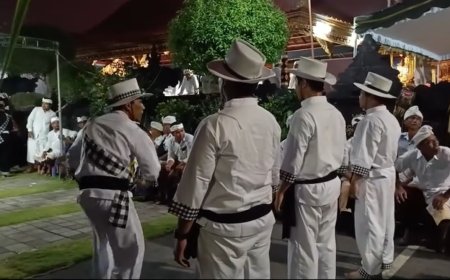Kreteg Tua Sibang Gede: The Mystery of a Centuries Old Bridge
The ancient bridge at Sibang Gede, known as the kreteg tua, dates back to 1749 and is an important bridge that connects Sibanggede Village with Darmasaba Village in Abiansemal District, Badung. Although the bridge is not located close to a major road or highway, it is still used as the main access for the local community in their daily activities.

In Bali, some places are known to have a mystical feel, and are often associated with stories about supernatural entities that are believed to guard the area. One location that has attracted attention is the old bridge or commonly called “Kreteg Tua Sibanggede” that connects Sibanggede Village and Darmasaba Village in Abiansemal District, Badung. Locals are not sure when the bridge was built or who built it. The only thing that is certain is that the bridge is made of solid stone without cement or soil adhesives, but it can still stand firmly until now. Solid stone is a volcanic rock formed by sedimentation and weathering, resulting in a stone with a porous texture that is easy to chisel. Because of this characteristic, it is widely used in traditional building construction in Bali.
Uniquely, this bridge is considered to have unusual strength due to its ability to last for hundreds of years. As if sustained by supernatural forces or miracles, the bridge is still the main route for local people to carry out their daily activities. More than just a physical access point, the bridge also commands respect and trust from the locals, who sometimes attribute it to ancestral stories or spiritual forces that are believed to protect the structure from natural deterioration.

Current Condition of Sibanggede Old Bridge (Photo Source: Personal Collection)
The historical story of this bridge is related to two figures, I Gusti Agung Kamasan Sakti III and I Gusti Agung Mambal Sakti III, who were moved to build this bridge to facilitate the mobility of residents who previously had to cross the river. According to stories circulating in the community, the construction of this bridge involved the utilization of the power of niskala, where the solid stone used was brought with the help of spirits. The process involved collecting large solid stones that were cut and glued together using red soil. The bridge, which is approximately 30 meters long, 6 meters wide and 20 meters high, was built using a method that adjusted the contours of the cliff and the depth of the river below, which reaches 8.5 meters.
The construction of the bridge began with the cutting of large solid stones that were glued together using red soil. The construction concept was designed with solid stones arranged to the north and south cliff sides and jutting into the center of the river to increase strength. The top of the bridge, which connects the Darmasaba and Sibanggede villages, was the most challenging part as it sits directly above the river with no support from the solid rock below and limited technology at the time. The piles of solid rock at the top of the bridge were made in several layers to withstand the heavy loads that would cross the bridge later,
It is said that when asking for help from the residents to build this bridge, I Gusti Agung Kamasan Sakti III, together with I Gusti Agung Mambal Sakti III, there were some residents who could not help make the bridge because of illness. As a leader with his magic at that time, I Gusti Agung Kamasan Sakti III, together with I Gusti Agung Mambal Sakti III even tested the truth of the reason for one of the residents' illness by transferring the resident's boils to himself, if he really felt pain in his body, it meant that the resident was not lying and the permission not to participate in building the bridge was approved.

Temple Around Sibanggede Old Bridge (Photo Source: Personal Collection)
After the bridge was completed, an inscription written in Balinese script was carved in a cave on the side of Sibanggede. There are two inscriptions on the north and south sides of the cave, as well as a pelinggih in the area. Until now, residents still pray at the place and offer offerings every time they pass by the kreteg tua.
The bridge is now in a pretty bad condition considering the age of the kreteg tua bridge is hundreds of years old. The shape of the bridge has begun to erode and shows a large hole in the center, indicating that this historic structure has been damaged by time. The eroded part has caused a large hole and is overgrown with shrubs. Road users often have to take turns to pass with caution, as the damaged sections can be dangerous. This relic from the Mengwi Kingdom era seems to have been left unattended and left to age.






























































